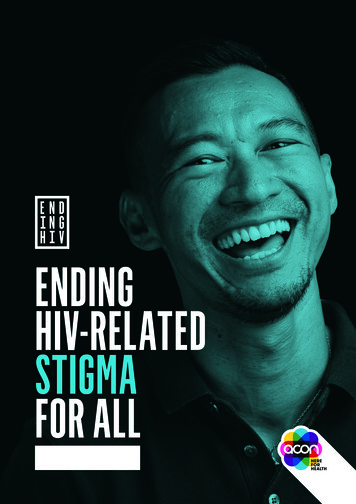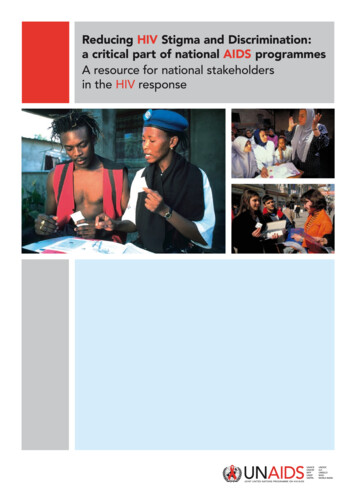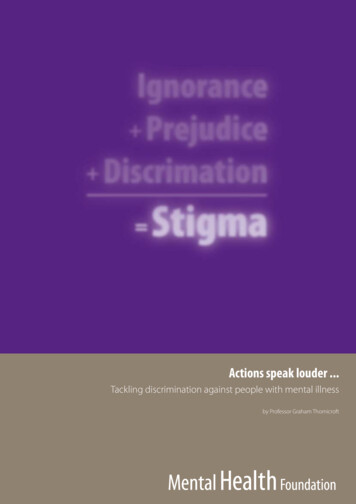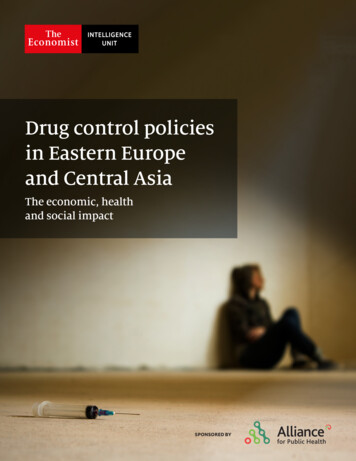
Transcription
ENDINGHIV-RELATEDSTIGMAFOR ALL
ABOUT ACONACON is NSW’s leading health organisationspecialising in community health, inclusion andHIV responses for people of diverse sexualities andgenders. Established in 1985, ACON works to createopportunities for people in our communities to livetheir healthiest lives.ACKNOWLEDGEMENTSWe would like to thank all our exceptional staffand friends who shared their personal stories,reflections, ideas and expertise to inform thedevelopment of this report: Dai Aoki, Russ Gluyas,Karl Johnson, Angus Molyneux, Joel Murray, LionelRabie, Tobin Saunders, Jane Strange, Rod Smith,Matthew Vaughan, Justin Xiao and Tim Wark.We are grateful to Tess Ziems for her preciousassistance with proofreading and to our everpatient and talented graphic designers, KosakuMakino and Emily Spencer.We pay our respects to the Traditional Owners of allthe lands on which we work, and acknowledge theirElders, past, present and emerging.ACON PO Box 350 Darlinghurst NSW 1300 AustraliaP: 02 9206 2000E: acon@acon.org.auW: www.acon.org.au ACON 2017ISBN: 978-1-86356-010-8Suggested citation: Delhomme, F., Mackie, B. (2020)Ending HIV-related Stigma for All. Sydney: ACON.Special thanks to Niamh Joyce from the HIV/AIDSLegal Centre and Bella Bushy from Positive LifeNSW for their insights and support.Ending HIV-related Stigma for All
CONTENTSI.Executive Summary5Introduction6CONTEXT– POLICY AND LEGAL FRAMEWORKS71. Greater & Meaningful Involvement of People Living with HIV 7II.III.IV.2. Stigma & Discrimination in HIV Strategies83. HIV-related Stigma & Discrimination and the Law9PREVALENCE AND FORMS OF HIV-RELATEDSTIGMA & DISCRIMINATION111. Stigma in Everyday Life112. Stigma in Care Settings143. Intersecting Stigma15THE IMPACTS OF HIV-RELATEDSTIGMA & DISCRIMINATION– WHY ADDRESSING STIGMA MATTERS181. Impacts of Stigma on HIV Testing182. Impacts of Stigma on Treatment Initiation,Access and Retention in Care193. Impacts of Stigma on PLHIV’s Related Quality of Life20HOW TO REDUCE HIV-RELATEDSTIGMA & DISCRIMINATION211. Changing Community Attitudes and Behaviours212. Gaining Power over Stigma233. Addressing Structures of Inequality and Exclusion25Conclusion: A Combination Approach toEliminate HIV-related Stigma in NSW27Recommendations28References29Ending HIV-related Stigma for All
END TRANSMISSIONEND STIGMAEnding HIV-related Stigma for All4
EXECUTIVESUMMARY HIV-related stigma refers to the negative beliefs,attitudes, fears and judgements held againstpeople living with HIV (PLHIV) and members ofgroups that are perceived to be associated withHIV, such as gay and bisexual men, people whoinject drugs and sex workers. HIV-related discrimination is the unfair and unjusttreatment of a person or group of people basedon their real or perceived HIV status. It is illegal todiscriminate against PLHIV in NSW. The Eighth National HIV Strategy 2018-2022 1has set strong stigma reduction targets and hasreaffirmed a commitment to the rights of PLHIV,including the right to participate fully in societyand the Greater and Meaningful Involvement ofPLHIV (GIPA/MIPA) principle. PLHIV in Australia continue to experience HIVrelated stigma. Stigmatising behaviours takemany forms, overt or subtle, online or in reallife. Discrimination can occur in personalrelationships and in relation to employment,insurance, accommodation and other services. A third of PLHIV in Australia report experiencingnegative or different treatment by healthcareworkers because of their HIV status. Poor HIVliteracy contributes to unfounded fears andthe perpetuation of stigmatising behaviours inhealthcare and aged care settings. Discrimination can feed negative beliefs PLHIV mayhold about themselves (e.g., self-stigma), therebyimpacting their mental health and quality of life. HIV-related stigma is often compounded withprejudices based on sexuality, gender, race, druguse, sex work and other diseases (e.g., hepatitisC). More research is needed to understand theimpacts of intersecting stigma – the associationof multiple stigmatised identities – on PLHIVwho are Aboriginal and/or Torres Strait Islander,migrants, of colour, culturally and linguisticallydiverse and/or trans or gender diverse. HIV-related stigma has real consequences onthe health-related quality of life of PLHIV. Stigmaleads to poorer physical and mental healthoutcomes. It is a barrier to accessing healthcareand may contribute to incomplete disclosureabout health status and medications by patients. HIV-related stigma hinders efforts to end HIVtransmissions for all in NSW. It acts as a barrierfor HIV testing, immediate treatment initiationand adherence. Undiagnosed HIV, or latediagnoses, are persistent, and present high risksfor the individual and the community as onwardtransmissions may continue. A combination approach is required to eliminatestigma at an individual, community andstructural level. This includes: Empowering PLHIV to build resilience andmobilise as a community to challenge stigma.This can be done by addressing anticipated,perceived and internalised stigma. Changing attitudes towards HIV and PLHIV.This includes programs to improve HIV literacyand dispel myths about HIV, connect HIVpositive and HIV-negative people, develop skillsto recognise and address stigma, and promotepositive representations. Having a legal environment that is informedby public health evidence and conducive tocommunity education is vital. This meanskeeping strong anti-discrimination protections,refuting proposed legislation that is notevidence-based and likely to strengthenstigma by promoting outdated and incorrectinformation about HIV, adequately fundingcare services, including aged care, andrepealing laws that discriminate against keypopulations affected by HIV (drug laws andimmigration laws).Ending HIV-related Stigma for All5
INTRODUCTIONWhile leaps in antiretroviral treatments andbiomedical prevention have radically changed theHIV landscape in Australia, living with a condition forwhich a cure is yet to be found still presents individualand collective challenges for the community of peopleliving with HIV (PLHIV).PLHIV contend with a world where societal attitudestowards HIV, and towards people, behavioursand identities associated with HIV, have notchanged as rapidly as science. In the age ofUndetectable Untransmissible (i.e. the fact that PLHIVwho have an undetectable viral load cannot pass onthe virus to others) stigma remains unchanged.Fear related to HIV was widespread and amplified bywell-intentioned public health campaigns in the late1980s and early 1990s. Since then, no commensuratemainstream educative efforts have taken placeto update the population on the contemporaryexperience of HIV. It is not surprising, therefore, thatoutdated attitudes remain which feed the experienceof stigma that is commonplace today.HIV-related stigma refers to the negative beliefs,attitudes, fears and judgements held against PLHIVand members of groups that are perceived to beassociated with HIV, such as gay and bisexual men,people who inject drugs and sex workers. HIV-relatedstigma may also become internalised by PLHIV and,through perceptions or anticipations of stigma, affecttheir social interactions with other people.HIV-related discrimination is the enactment of HIVrelated stigma – the unfair and unjust treatment ofa person or group of people based on their real orperceived HIV status.As the New South Wales Government prepares thenext HIV Strategy 2021-2025, this paper investigatesthe state of HIV-related stigma today, its impacts andhow it can be addressed to improve outcomes notonly for those who are directly affected by it – PLHIV– but also to enhance efforts to end HIV transmissionsfor all. While primarily focused on what NSW can do,the paper’s findings bear on the broader nationalcontext as well.Section one provides an overview of how HIV-relatedstigma is envisaged in policy responses. HIV-relatedstigma is a priority for national and NSW HIVresponses, and, in many aspects of daily life, HIVrelated discrimination is against the law in NSW.Section two highlights the prevalence of HIV-relatedstigma in NSW today, both in day-to-day socialinteractions and in healthcare. It also points torenewed understandings of intersecting stigma – theconvergence of multiple stigmatised identities. Ratherthan operating in a vacuum, HIV-related stigmais intimately linked to mechanisms of exclusion –homophobia, transphobia, biphobia, gender violence,racism & xenophobia, and moralising attitudestowards drug use and sex work.HIV-positive women, Aboriginal and Torres StraitIslander people, trans and gender diverse people,migrants, people who use drugs, and sex workers facecomplex, compounded levels of stigma.Section three focuses on the impacts of stigma onPLHIV and on public health more broadly. Stigma actsas a barrier to testing and service access for prioritypopulations, including for migrant gay and bisexualmen who now account for most new HIV notificationsin NSW. As such, stigma hinders efforts to end HIVtransmissions.Finally, section four reviews effective interventions toeliminate stigma. No single stigma intervention caneliminate stigma on its own. Rather, a combinationof approaches that are designed and implementedwith the meaningful involvement of PLHIV andaddress stigma at multiple levels can durably reduceHIV-stigma and its effects. This means investing ininitiatives to change attitudes towards HIV and PLHIV,strengthening the resilience of PLHIV, and addressingstructural causes of inequality and exclusion. HIVstigma is often a by-product of laws that criminaliseHIV or people associated with HIV.Ending HIV-related Stigma for All6
I.CONTEXT – POLICY ANDLEGAL FRAMEWORKSIn Australia, the positive community hassuccessfully advocated for effective, rights-basedHIV responses. The Greater and MeaningfulInvolvement of PLHIV/AIDS (GIPA/MIPA), hascontributed to making the fight against HIV-stigmaa priority in global and national strategies (2)and in Australian and NSW anti-discriminationlegislation (3).1. Greater & Meaningful Involvementof People Living with HIVThe Greater and Meaningful Involvement ofPLHIV/AIDS (GIPA/MIPA) is a fundamental guidingprinciple for the design and implementation ofrights-based, effective strategies to eliminatestigma and discrimination against PLHIV.Initially stemming from the 1983 Denver Principlesand later the 1994 Paris Declaration2, the GIPAand MIPA aim to realise PLHIV’s rights to selfdetermination and participation in decision-makingprocesses that affect their lives.MIPA/GIPA are recognised, globally and nationally,as a key feature of effective HIV responses. As notedby UNAIDS, “experiences have shown that whencommunities are proactively involved in ensuringtheir own well-being, success is more likely. GIPAseeks to ensure that PLHIV are equal partners andbreaks down simplistic (and false) assumptions of“service providers” (as those living without HIV) and“service receivers” (as those living with HIV).”3The importance of GIPA/MIPA in combatting HIVstigma is two-fold. At program level, initiatives tocombat HIV-stigma are more likely to be effective ifthey are informed, designed and implemented withthe meaningful involvement of PLHIV. At a policylevel, by being meaningfully involved in designingHIV responses, the positive community has beenable to shape key Government policies, strategiesand laws, and ensure the inclusion of anti-stigma asa key priority for action.The diversity of the PLHIV community should bereflected in HIV responses. HIV-positive people whoare Aboriginal and Torres Strait Islander people,migrant, of colour, culturally and linguisticallydiverse, trans and gender diverse, and/or whowork in the sex industry and/or who inject drugsshould be meaningfully included in the design andimplementation of research, policies and programs.Ending HIV-related Stigma for All7
2. Stigma & Discrimination in HIV StrategiesAction against HIV-related stigma is considereda priority under international and national HIVstrategies, and an enabling factor to effective HIVprevention in NSW.Globally, the UNAIDS 2016–2021 Strategy4, Onthe Fast-Track to end AIDS, aims to achieve zerodiscrimination. To do so, core actions includeeliminating discrimination and stigma againstpeople living with, at risk of and affected byHIV, including in health care, workplace andeducational settings, as well as removing punitivelaws, policies, and practices that violate humanrights, increase people’s vulnerability to and risk ofacquiring HIV and impede utilisation of services.In Australia, policy makers have long recognisedthat action against discrimination, through the lawand community education, is key to HIV preventionand to “ensure that people with HIV [ ] retain theright to participate in the community and the samerights as other people”.5The Eighth National HIV Strategy 2018-2022has reaffirmed the Australian Government’scommitment to ensuring PLHIV’s rights, includingthe right to participate fully in society, and set thegoal of eliminating the negative impact of stigmaand discrimination.1 These goals are backed upby a target to reduce by 75 per cent the reportedexperience of stigma among PLHIV, and expressionof stigma, in relation to HIV status (comparedwith a 2018 baseline), and a target of 75 per centof people with HIV reporting good quality of life.The Strategy does not, however, refer to specificprogramming or funding instruments for therealisation of these goals.Relevant NSW policy documents currentlyenvisage stigma primarily as an HIV preventionimplementation issue. The NSW HIV Strategy2016 – 2020 does not contain specific targets inrelation to HIV-stigma but describes “maintainingan enabling environment to reduce stigma anddiscrimination” as an enabler to reach the goalof eliminating HIV transmissions.6 The Strategyis completed with the NSW BBV and STI jointwork plan to address Stigma and Discrimination2019/2020, which proposes a range of initiativesthat aim to 1) remove barriers to testing, treatmentand prevention for BBVs and STIs in prioritypopulationsi; and 2) enable affected communitiesto provide direct and timely feedback about theirhealth outcomes and experiences.i P riority populations for BBVs and STIs include PLHIV, Hepatitis C and Hepatitis B, gay and homosexually active men, Aboriginal people, sex workers, people who inject drugs, and people from culturally and linguistically diverse backgrounds.Ending HIV-related Stigma for All8
The development of the NSW HIV Strategy 20212025, currently underway, offers an opportunity toalign State and National stigma reduction targets,priority areas of work, and community involvementstandards (MIPA/GIPA). The Victorian HIV Strategy2017-2020 also provides an interesting modelfor GIPA/MIPA standards, and ambitious stigmareduction targets.73. HIV-related Stigma & Discrimination and the LawAnti-stigma and anti-discrimination laws toprotect PLHIV and stigmatised communitiesassociated with HIV have long been a key featureof Australia’s world-leading HIV responses.The 1989 National HIV/AIDS Strategy set outa suite of wide-ranging legislative reform toprotect the rights of PLHIV – including healthcare,housing, employment and confidentiality rights;address discrimination; and ensure laws areevidence-based and enable HIV prevention. It iswith these three pillars in mind that we will nowexamine recent developments in contemporaryHIV law and the threats they are facing.Protecting the rights of people living withHIV and people associated with HIVAs early as 1989, the National HIV/AIDS Strategyset out to ensure that people with HIV “have thesame rights as other people to comprehensiveand appropriate health care, income support andcommunity services, [and] protection against unfairdiscrimination”.5 Subsequent legislative reformsat Commonwealth and State level substantiallyprotect those rights.NSW policy makers have also long understood thatdiscrimination based on HIV disproportionatelyaffects already stigmatised communities, includinggay men, sex workers and people who injectdrugs. Many of the laws that were criminalisingor stigmatising PLHIV and/or priority populationsat risk of HIV in NSW have now been removed orchanged.ii This includes the decriminalisation of sexwork in 1995, legislative instruments that allowedsome drug harm reduction measures, and thegradual advancement of gay, bisexual and transpeople’s rights.Protecting against discrimination, threats and violenceTreating someone unfairly based on their actualor perceived HIV status is unlawful in Australia. TheCommonwealth Disability Discrimination Act 1992makes it against the law to discriminate againsta person because of their HIV status, including inemployment, education, services, renting or buyinga house and accessing public places or facilities.8Discrimination against people believed to have HIV,and those who associate with them, is also banned.It is also against the law to vilify, threaten orincite violence against PLHIV in NSW. Banned inNSW under the NSW Anti-Discrimination Act 1977,vilification is a public act that incites hatred,serious contempt or severe ridicule towardspeople because they are or are perceived to behomosexual, HIV positive, transgender, or of aparticular race. Under the NSW Crimes Act 1900,public threats of violence or incitement to violenceagainst another person or a group of personsbecause of their HIV/AIDS status, sexual orientation,ii S ex work remains criminalised, or partially criminalised, in other Australian states and territories. Visit www.scarletalliance.org.au forup-to-date information on the laws in each jurisdiction.Ending HIV-related Stigma for All9
gender identity, intersex status, race, or religion arean offence.9From time to time – as is currently the case inNSW10– parliaments are asked to consider proposedlegislation that would dismantle, unwind orotherwise weaken the protections and rights inantidiscrimination legislation. In these instances,while organisations with expertise in HIV makestrong, evidence-based representations, otheropinions and non-evidence-based views can bedifficult to counter. Disadvantaged HIV positivepopulations do not carry sufficiently strong voicesto carry the day and, at times, those who advocatewith us are marginalised alongside us. A broader,contemporary understanding of HIV and itstransmission is required to alter this situation.Evidence-based public health legislationPublic health legislation in NSW has evolved overtime to reflect progress in scientific understandingsof the virus and effective prevention options,thereby creating a less stigmatising environment.This includes changes to the NSW Public HealthAct in 2017, which mean that people with HIV areno longer legally required to disclose their statusto sexual partners but must take reasonableprecautions to prevent transmission of HIV.iii Thesechanges better reflect well-established evidenceof the effectiveness of antiretroviral treatment,and other prevention methods, to stop onwardtransmission.11facility, GP, private health services) but penaltiesapply to staff who inappropriately access healthinformation, including disciplinary action andpotential criminal charges.12Recent attempts to alter the basic principle thatpublic health laws should be evidence-based andcompatible with human rights pose a major threatto NSW’s HIV responses. Since 2017, a police unionhas been lobbying for the introduction of new lawsthat would force people whose bodily fluids comeinto contact with police and emergency servicespersonnel to take an HIV test.13-14 This means thatsomeone spitting on a police officer could beforced, by law, to take an HIV test, despite wellestablished evidence that HIV cannot and has neverbeen transmitted by spitting.15Ever since the first National HIV/AIDS Strategy in1989, HIV testing has been voluntary. Introducingmandatory testing for HIV would propagate fear andfalsehoods about HIV transmissions and, as such,jeopardise NSW’s world leading and science-basedHIV responses.16HIV simply does NOT get passed on through spitting,kissing, touching, shaking hands. HIV does NOT getpassed on through saliva, sweat, tears, mucous,vomit, urine or faeces.Because it is upon disclosure that PLHIV are mostlikely to experience stigma, ensuring strong privacylaws is essential.In NSW, public health legislation offers someprivacy and confidentiality protections. The NSWPublic Health Act, and the Health Records andInformation Privacy Act 2002 set some limits onhow people’s health information, including HIVinformation, can be used and disclosed. HIV statusmay be disclosed to a person involved in someone’scare (staff at any NSW public hospital or healthiii T he means of minimising the risk of transmitting HIV to sexual partners and the precautions that should be taken to minimise therisk, may include the following: using a condom during sexual intercourse, the HIV positive partner seeking and receiving confirmation from a sexual partner that the sexual partner is on HIV pre-exposure prophylaxis medication, or the HIV positive partner knowingthat he or she has an HIV viral load of less than 200 copies/mL. ACON recommends that people living with HIV consult their doctorabout the best ways to protect their sexual partners in their specific circumstances.Ending HIV-related Stigma for All10
I I.PREVALENCE AND FORMSOF HIV-RELATED STIGMA &DISCRIMINATIONWhile HV-related discrimination is illegal in NSW,subtle manifestations of stigma can be hard tochallenge. In social situations and institutionalsettings (e.g. healthcare and aged care), HIVstigma is often compounded with prejudices basedon sexuality, gender, race, migration, or behaviourssuch as drug use and sex work.1. Stigma in Everyday LifePLHIV continue to report high levels of stigma.In 2018, more than half (56%) of PLHIV whoparticipated in the HIV Futures 9 study reportedexperiencing some form of stigma in the past 12months, including 9% reporting that they ‘often’or ‘always’ experienced stigma.17 While theseproportions are lower than in a survey conductedtwo years prior, methodological differencesbetween the two surveys make it difficult to confirmwhether stigma is indeed abating.18What stigma looks likeStigma is the product of views held by HIV-negativepeople towards HIV or PLHIV (i.e. interpersonalstigma19). Stigmatising behaviours can occur inmany forms, online or in real life. This includesovert forms of stigmatising behaviour (e.g. rejectingsomeone online because of their positive HIVstatus), and more subtle forms, unconscious biasand micro-aggressions.Examples of stigmatising behaviours include: Blaming or shaming someone, privately orpublicly, because of their HIV diagnosis. Making assumptions about someone’s HIV status(i.e., assuming a person is HIV negative). Casting judgements about the actions orcharacter of PLHIV (e.g., judging someone as too“promiscuous”).Ending HIV-related Stigma for All11
Using offensive or derogatory language todescribe PLHIV (e.g., ACON Peer Testers reportlanguage such as “dodgy” or “dirty” being usedby HIV-negative gay men to describe people orbehaviours that they associate with HIV). Disclosing someone’s HIV status without theirconsent (e.g., a disgruntled ex-partner publiclysharing someone’s HIV status on Facebook; anewspaper publicly disclosing that someonehas HIV). Ignoring scientific evidence on HIV and takingunnecessary precautions when interacting withsomeone living with HIV (e.g., refusing to shakethe hand of someone living with HIV). Stating a preference against PLHIV or rejectingsomeone because of their HIV status (e.g., ondating apps). To make matters worse, thesepreferences are often expressed in offensive orderogatory language (e.g., someone indicatingthat they are looking for “clean guys” or“clean fun”).The reality of PLHIV’s experience of interpersonalstigma is attested by surveys of the generalpopulation. In a recent study, only 48% ofrespondents declared that they would never behavenegatively towards people because of their HIV.20HIV-related stigma and discrimination can alsoaffect HIV-negative people who are perceived to beassociated with HIV or someone living with HIV. Onestudy estimated that one in five partners of PLHIV inhigh-income countries report experiencing stigmaas their biggest challenge as a partner of someoneliving with HIV.21 Healthcare workers caring forpeople living with HIV may be subject to HIV-relateddiscrimination by proxy as well.22Internalised stigmaInternalised, or self-stigma, refers to the negativeviews PLHIV may hold about themselves. PositivePerspectives, a survey of PLHIV in nine high-incomecountries, including Australia, found that selfstigma continues to have a big impact on the livesof PLHIV.23 Over a quarter of respondents statedfeelings of self-blame, guilt and a need for secrecy.This survey echoes many of the insights shared byparticipants in ACON’s workshops, including thefollowing comment:“I felt as a gay man with HIV I am second rate,tainted, damaged”Such feelings may be particularly exacerbatedfor those who held negative views about HIV, and/or behaviours or identities associated with HIV,before their diagnosis. Research among migrants toAustralia suggests that perceptions of HIV formedin countries where the virus is stigmatised or, evencriminalised, may contribute to internalised stigmalater in life (see section III.1).While self-stigma is a highly personal experience,the internalised beliefs that PLHIV may hold aboutthemselves also speak to structures of exclusion.One study found that the most common evidenceof HIV-related stigma arose when PLHIV describedhow they felt about themselves when disclosingtheir status, with a recurring use of metaphorsabout feeling dirty. Drawing on anthropologicalliterature24, the National Association of PLHIVAustralia (NAPWHA) interprets this aspect ofinternalised stigma as the effect of social powerstructures that exclude and devalue people whodon’t fit the norm. 25Ending HIV-related Stigma for All12
U U, Sex & StigmaA large body of clinical evidencehas validated the concept of HIVUndetectable Untransmissible (U U)and treatment as prevention26-27-28-29.U U means that people with HIV whoreceive antiretroviral therapy andmaintain an undetectable viral loadcannot sexually transmit the virusto others. Treatment as prevention isthe use of antiretroviral medicationto prevent the transmission of HIV tosexual partners.Health promotion efforts, includingACON’s Ending HIV campaign, haveled to a greater understanding ofthe effectiveness of treatments in thegay community. In April 2019, 83%of respondents to our Ending HIVsurvey agreed that “HIV treatmentssignificantly reduce the risk ofpassing on HIV” compared with 33%in February 2013. 93% also agreedthat “early HIV treatment is betterfor your health and can help protectyour sex partners”, compared with74% six years prior.intercourse with casual partners,just over 20% reported using UVL asa prevention strategy, on its own orcombined with additional preventionstrategies such as PrEP.While it is hard to estimate whetherU U knowledge has translated intobehaviour change, the 2020 SSydneyGay Community Periodic Surveyoffers some indications about the useof treatment as prevention.30 Havingan undetectable viral load (UVL) is theprevention strategy most commonlyused by HIV-positive participants whohave condomless anal intercourse withcasual partners. Among HIV-negativemen who engage in condomless analWhere discrimination occursHIV discrimination can occur in a range of settings,including in social interactions, at work or whenaccessing or attempting to access services.HIV-positive and HIV-negative participants in ACONprograms highlight that verbal abuse and rejectionbased on HIV status is commonplace on hook upapps, and particularly violent when perpetratedanonymously.Participants in the HIV Futures 9 study reportedexperiencing HIV-based discrimination in relationto health services (25.7%), insurance (25%),employment (18.8%) and accommodation (8%) inthe last year.17These statistics align with reports by the HIV/AIDS Legal Centre (HALC), a Sydney-based legalcentre specialising in assisting people in NSWwith HIV or Hepatitis-related legal matters, thatapproximately half of their clients come to them toresolve matters related to employment, insurance(incl. total permanent disability cases), otherforms of discrimination, and wills and estates. TheAnecdotally, ACON’s HIV-negativeclients report understanding thescience behind UVL but prefer to useprevention methods such as PrEP thatare within their control, rather thantheir partner’s.Sexual rejection because of HIV is oftenreported by PLHIV. The HIV Futures 9study found that 18.4% of HIV positivepeople in Australia report that peopleoften or always did not want to havesex or an intimate relationship becauseof their HIV status.17other half of HALC’s clients come to them to resolveimmigration issues (see section IV).HIV-discrimination in employment often occurs as aresult of pre-employment health-checks, accordingto HALC. While occupational health screeningsare intended to ensure employees are fit for workand not using medication that may pose a risk tooccupational health and safety (e.g. drowsiness forheavy machinery operators), they place PLHIV ina vulnerable position. By disclosing that they areusing HIV medication, they are forced to disclosetheir HIV status and may face discrimination that ishard to prove, but not answering a health screeningprocess truthfully may also expose them to beingfired for breaching their disclosure obligations.Discrimination is fundamentally incompatible withPLHIV’s right and aspiration to participate fully insociety. A participant in one of ACON’s workshopsexplained:“I want to live a normal life as everybody else,I want to be viewed and treated as normal, justlike everybody else”Ending HIV-related St
Section one provides an overview of how HIV-related stigma is envisaged in policy responses. HIV-related stigma is a priority for national and NSW HIV responses, and, in many aspects of daily life, HIV-related discrimination is against the law in NSW. Section two highlights the prevalence of HIV-related stigma in NSW today, both in day-to-day .










